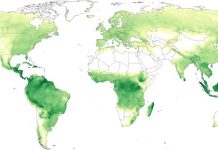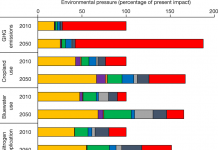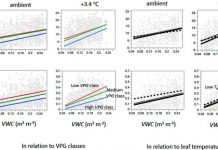【青藏高原高寒草地土壤中脂肪酸的分布特征】Dai G H Zhu S S Liu Z G Chen L T He J S Feng X J. 2016. Distribution of fatty acids in the alpine grassland soils of the Qinghai-Tibetan Plateau.Science China Earth Science 59: 1329–1338 doi: 10.1007-s11430-016-5271-2
Abstract
As an important biomarker fatty acids (FAs) have been extensively used to trace the origin of organic matter in sediments and soils. However studies of the distribution and abundance of FAs in alpine grassland soils are still rare especially on the Qinghai-Tibetan Plateau (QTP) the highest plateau in the world which contributes sediments to many large rivers in Asia. This study investigates the composition distribution and source of FAs with increasing soil depths from 17 typical alpine grassland sites in the QTP. The most abundant FAs included the ubiquitous C16 FA and even-numbered long-chain FAs (C20–C30) indicating mixed inputs from microbial and higher plant sources. Source apportionment showed that higher plants were the dominant contributor of FAs (approximately 40%) in QTP soils. The abundance of FAs decreased with soil depth with the highest value (1.08±0.09 mg-g OC) at a 0–10 cm depth and the lowest value (0.46±0.12 mg-g OC) at a 50–70 cm depth due to much lower plant inputs into the deeper horizons. The total concentration of FAs was negatively correlated to the mean annual temperature (MAT; P<0.05) and soil pH (P<0.01) suggesting that the preservation of FAs was favored in low-MAT and low-pH soils on the QTP. The abundance of fresh OC source FAs increased significantly with the mean annual precipitation (MAP; P<0.05) indicating that high MAP facilitates the accumulation of fresh FAs in QTP soils. Other environmental parameters such as the soil mineral content (aluminum and iron oxide) microbial community composition as well as litter quality and quantity may also exert a strong control on the preservation of FAs in QTP soils and warrant further research to better understand the mechanisms responsible for the preservation of FAs in QTP soils.
脂肪酸,作为一种重要的生物标志物,已被广泛用于土壤和沉积物中有机质来源的示踪。最近一项关于青藏高原高寒草地土壤中脂肪酸分布特征的研究,表明青藏高 原高寒草地土壤中的脂肪酸主要源于植物组织,低温和低的土壤pH条件有利于土壤中脂肪酸的保存,该项研究为进一步揭示全球气候变化背景下青藏高原土壤碳动 态提供了重要的理论依据。
相关论文题目为:“Distribution of fatty acids in the alpine grassland soils of the Qinghai-Tibetan Plateau”,出版于2016年第7期SCIENCE CHINA earth sciences(《中国科学:地球科学》英文版),由中国科学院植物研究所戴国华博士担任第一作者,冯晓娟研究员担任通讯作者共同撰写。研究者以分子水平的生物标志物为主要技术手段,揭示了青藏高原高寒草地土壤中脂肪酸分布特征研究。
青藏高原是世界上海拔最高的高原,也是亚洲许多大河沉积物的主要源。近年来,一些研究者指出青藏高原是全球气候变化的高度敏感区,全球气候变化会导致青藏 高原高寒草地退化和土壤有机质在微生物降解和河流迁移作用下的大量流失。然而目前对青藏高原土壤有机质的研究仍局限于碳、氮等整体参数的测定,而对青藏高 原高寒草地土壤中生物标志物的分析能更清晰的阐明全球气候变化背景下土壤的碳动态,并为示踪发源于青藏高原的河流沉积物的源提供重要信息。
该研究利用分子水平的生物标志物技术,首次进行了青藏高原高寒草地土壤中脂肪酸分布特征研究。通过对对青藏高原高寒草地17个采样点不同深度的土壤样品中 生物标志物脂肪酸的检测分析,并结合环境要素(气温、降水、土壤理化性质)数据,揭示了青藏高原高寒草地不同土层深 度脂肪酸的组成、来源和分布特征。该研究发现:高等植物对青藏高原土壤中脂肪酸含量的贡献达40%以上。脂肪酸总含量与年均温和土壤pH值呈显著负相关关 系,因此低温和低土壤pH更有易于青藏高原土壤中脂肪酸的保存。研究者指出,未来还应加强关于其它环境因素,如土壤矿物含量(铁、铝氧化物)、微生物群落 组成、枯落物的质量和数量等对青藏高原土壤中脂肪酸保留所起作用的进一步研究,以便更好地理解青藏高原高寒草地土壤中脂肪酸的保留机理。该研究为进一步探 讨青藏高原土壤有机碳来源、周转时间及对气候敏感性方面奠定了理论基础。(来源:EurekAlert!)
【根际微生物的相互作用】Shi SJ Erin E. Nuccio Zhou J. Shi Zhou JZ Mary K. Firestone. <







